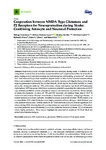Cooperation between NMDA-Type Glutamate and P2 Receptors for Neuroprotection during Stroke: Combining Astrocyte and Neuronal Protection
| dc.contributor.author | Vermehren, P | |
| dc.contributor.author | Trotman-Lucas, M | |
| dc.contributor.author | Hechler, B | |
| dc.contributor.author | Gachet, C | |
| dc.contributor.author | Evans, R | |
| dc.contributor.author | Gibson, C | |
| dc.contributor.author | fern, robert | |
| dc.date.accessioned | 2021-09-20T12:18:04Z | |
| dc.date.available | 2021-09-20T12:18:04Z | |
| dc.date.issued | 2018-03-14 | |
| dc.identifier.issn | 2571-6980 | |
| dc.identifier.issn | 2571-6980 | |
| dc.identifier.uri | http://hdl.handle.net/10026.1/17857 | |
| dc.description.abstract |
<jats:p>Excitotoxicity is the principle mechanism of acute injury during stroke. It is defined as the unregulated accumulation of excitatory neurotransmitters such as glutamate within the extracellular space, leading to over-activation of receptors, ionic disruption, cell swelling, cytotoxic Ca2+ elevation and a feed-forward loop where membrane depolarisation evokes further neurotransmitter release. Glutamate-mediated excitotoxicity is well documented in neurons and oligodendrocytes but drugs targeting glutamate excitotoxicity have failed clinically which may be due to their inability to protect astrocytes. Astrocytes make up ~50% of the brain volume and express high levels of P2 adenosine triphosphate (ATP)-receptors which have excitotoxic potential, suggesting that glutamate and ATP may mediate parallel excitotoxic cascades in neurons and astrocytes, respectively. Mono-cultures of astrocytes expressed an array of P2X and P2Y receptors can produce large rises in [Ca2+]i; mono-cultured neurons showed lower levels of functional P2 receptors. Using high-density 1:1 neuron:astrocyte co-cultures, ischemia (modelled as oxygen-glucose deprivation: OGD) evoked a rise in extracellular ATP, while P2 blockers were highly protective of both cell types. GluR blockers were only protective of neurons. Neither astrocyte nor neuronal mono-cultures showed significant ATP release during OGD, showing that cell type interactions are required for ischemic release. P2 blockers were also protective in normal-density co-cultures, while low doses of combined P2/GluR blockers where highly protective. These results highlight the potential of combined P2/GluR block for protection of neurons and glia.</jats:p> | |
| dc.format.extent | 30-47 | |
| dc.language | en | |
| dc.language.iso | en | |
| dc.publisher | MDPI | |
| dc.subject | Stroke | |
| dc.subject | Brain Disorders | |
| dc.subject | Neurosciences | |
| dc.subject | 1.1 Normal biological development and functioning | |
| dc.subject | Neurological | |
| dc.title | Cooperation between NMDA-Type Glutamate and P2 Receptors for Neuroprotection during Stroke: Combining Astrocyte and Neuronal Protection | |
| dc.type | journal-article | |
| plymouth.issue | 1 | |
| plymouth.volume | 1 | |
| plymouth.publication-status | Published online | |
| plymouth.journal | Neuroglia | |
| dc.identifier.doi | 10.3390/neuroglia1010005 | |
| plymouth.organisational-group | /Plymouth | |
| plymouth.organisational-group | /Plymouth/Admin Group - REF | |
| plymouth.organisational-group | /Plymouth/Admin Group - REF/REF Admin Group - FoH | |
| plymouth.organisational-group | /Plymouth/Faculty of Health | |
| plymouth.organisational-group | /Plymouth/Faculty of Health/Peninsula Medical School | |
| plymouth.organisational-group | /Plymouth/REF 2021 Researchers by UoA | |
| plymouth.organisational-group | /Plymouth/REF 2021 Researchers by UoA/UoA01 Clinical Medicine | |
| plymouth.organisational-group | /Plymouth/Research Groups | |
| plymouth.organisational-group | /Plymouth/Research Groups/Institute of Translational and Stratified Medicine (ITSMED) | |
| plymouth.organisational-group | /Plymouth/Research Groups/Institute of Translational and Stratified Medicine (ITSMED)/CBR | |
| plymouth.organisational-group | /Plymouth/Users by role | |
| plymouth.organisational-group | /Plymouth/Users by role/Academics | |
| dcterms.dateAccepted | 2018-03-08 | |
| dc.rights.embargodate | 2021-9-21 | |
| dc.identifier.eissn | 2571-6980 | |
| dc.rights.embargoperiod | Not known | |
| rioxxterms.versionofrecord | 10.3390/neuroglia1010005 | |
| rioxxterms.licenseref.uri | http://www.rioxx.net/licenses/all-rights-reserved | |
| rioxxterms.licenseref.startdate | 2018-03-14 | |
| rioxxterms.type | Journal Article/Review | |
| plymouth.funder | Ion homeostasis in optic nerve astrocytes::BBSRC |


